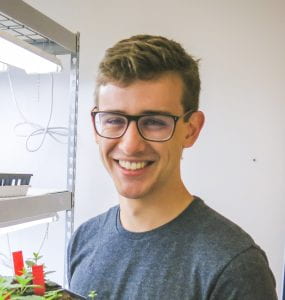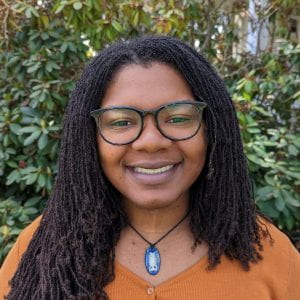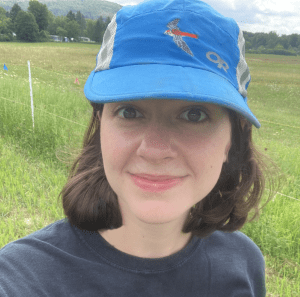From use of robotics for grape disease detection to drought-resistant crops in Morocco – these are just two of the diverse graduate student projects recently funded through the Schmittau-Novak Small Grants Program. Supported by a bequest from the estate of Jean Schmittau in honor of Joseph Novak, Plant Biology Professor Emeritus, the Schmittau-Novak Small Grants Program is designed to provide graduate students in the School of Integrative Plant Science with the opportunity to experience the process of writing and reviewing proposals, and implementing a research plan of their own design. Seven proposals were selected for Spring 2023 funding. The program is directed by Dan Buckley and Teresa Pawlowska.
The missing link(er): phase-separated photosynthesis in algal ancestors of land plants
 Bryce Askey is a PhD student in the program of Laura Gunn.
Bryce Askey is a PhD student in the program of Laura Gunn.
All photosynthetic organisms depend on Ribulose-1,5-bisphosphate carboxylase/oxygenase (Rubisco) to fix gaseous CO2 into carbohydrates. Though vital, Rubisco is problematic because of its ability to accept O2 as a substrate instead of CO2. To overcome this, many algae species limit Rubisco’s reactions with O2 via sequestration into pyrenoids, chloroplast-localized compartments in which CO2 is enriched and O2 is excluded. Work in Chlamydomonas reinhardtii has demonstrated that a Rubisco-interacting linker protein is necessary for pyrenoid formation. However, engineering efforts with this linker in land plants have been hampered by their long evolutionary divergence from C. reinhardtii. Fortunately, pyrenoids are also present in Zygnematophyaceae, the algal lineage immediately sister to all land plants. To facilitate the introduction of a pyrenoid into a crop plant, I will develop a synthetic biology toolkit for the model Zygnematophyte species Penium margaritaceum, and apply it to identify potential pyrenoid linkers. The centerpiece of this toolkit will be an E. coli expression system for P. margaritaceum Rubisco, which I will establish and optimize with the help of an undergraduate student funded by this grant. This expression system and published transformation protocols will allow me to identify potential linkers via proximity labeling of the P. margaritaceum Rubisco interactome.
Investigating the DNA binding targets of DRMY1 using CUT&RUN

 Shuyao Kong is a fourth year Ph.D. candidate in Plant Biology Section advised by Professor Adrienne Roeder. His research focuses on the molecular mechanisms of developmental robustness in the Arabidopsis sepal
Shuyao Kong is a fourth year Ph.D. candidate in Plant Biology Section advised by Professor Adrienne Roeder. His research focuses on the molecular mechanisms of developmental robustness in the Arabidopsis sepal
David Pan is a sophomore at the College of Arts and Sciences double-majoring in Biological Sciences and Chemistry. He is an undergraduate researcher in the Roeder Lab advised by Shuyao Kong, focusing on robust sepal development in Arabidopsis thaliana. For fun, he loves to learn languages and lion dance.
Robustness is the reproducible development of phenotype despite environmental changes or stochastic gene expression. The Arabidopsis flower robustly develops four sepals of constant size and shape, enabling them to tightly enclose and protect the inner floral organs. We previously found a mutant in DEVELOPMENT RELATED MYB-LIKE1 (DRMY1), where flowers develop 3-6 sepals of variable sizes and shapes, causing gaps in the sepal whorl. We previously found that this loss of robustness is caused by disrupted spatial patterns of auxin and cytokinin signaling, two hormones critical to organogenesis. However, less is known about the molecular function of DRMY1 through which it regulates hormone signaling. DRMY1 is a MYB/SANT domain protein which indicates its role in transcriptional regulation. Previously, we were unable to characterize its genomic binding targets through ChIP-seq, likely due to its low level or the transient nature of DNA binding. Recent years have seen development of new techniques such as Cleavage Under Targets and Release Using Nuclease (CUT&RUN) to more sensitively characterize DNA-binding targets of transcriptional regulators. In this project, we will employ CUT&RUN to probe the binding targets of DRMY1 on the Arabidopsis genome, and validate selected binding targets using reverse genetics. By doing so, we hope to better understand whether and how DRMY1 regulates gene expression to control robust hormone patterning and robust organogenesis in the Arabidopsis floral meristem
An integrated, multimodal system for grape disease detection and monitoring
 Kathleen Kanaley is a PhD student in Dr. Katie Gold’s Grape Sensing, Pathology and Extension lab at Cornell AgriTech, using satellite, aerial, and terrestrial imaging systems to monitor grapevine diseases, with the goal of leveraging these data streams to improve disease management in commercial vineyards.
Kathleen Kanaley is a PhD student in Dr. Katie Gold’s Grape Sensing, Pathology and Extension lab at Cornell AgriTech, using satellite, aerial, and terrestrial imaging systems to monitor grapevine diseases, with the goal of leveraging these data streams to improve disease management in commercial vineyards.
 Ertai Liu is a PhD student in the program of Yu Jiang working on
Ertai Liu is a PhD student in the program of Yu Jiang working on
Grapevine downy mildew (GDM) and grapevine leafroll-associated virus 3 (GLRaV-3) are two of the most destructive grapevine diseases worldwide. Disease scouting is prohibitively time-consuming in most commercial vineyards, and accurate early detection poses a major challenge to GDM and GLRaV-3 management. Aerial remote sensing offers a promising alternative to manual scouting, enabling rapid data collection over large areas. We hypothesize that the distinct physiological responses elicited by each disease allow for detection and differentiation of GDM and GLRaV-3 via thermal and multispectral aerial image analysis. GDM, caused by the oomycete Plasmopara viticola, induces chlorophyll degradation, foliar necrosis and severe photosynthetic impairment, while GLRaV-3, a viral disease, increases foliar anthocyanin content and reduces transpiration. The spectral and thermal signatures of these symptoms have been well-characterized by proximal measurements in controlled environments. However, no prior studies address whether these changes can be detected at field scale using aerial multispectral and thermal imagery. We will pair a terrestrial autonomous rover and UAV imaging system to determine whether remote multispectral and thermal imagery can be used to detect GDM and GLRaV-3. Rover-generated disease ratings will serve as ground-truth to validate disease estimates derived from aerial image spectra. We will test the integrated terrestrial / aerial sensing system in two commercial vineyards to evaluate the utility of this approach for rapid detection of multiple diseases in different production environments.
Bridging molecular, physiological, ecological, biogeographical scales to understand how elevated temperature affects Palmer amaranth performance and control
 Aleah Butler-Jones is a second-year MS/PhD student in the Field of Horticulture, advised by Dr. Lynn Sosnoskie. Her research examines weed biology and management with a focus on novel technology. She is interested in evaluating the impact of alternative weed management strategies on weeds and the surrounding agroecological landscape.
Aleah Butler-Jones is a second-year MS/PhD student in the Field of Horticulture, advised by Dr. Lynn Sosnoskie. Her research examines weed biology and management with a focus on novel technology. She is interested in evaluating the impact of alternative weed management strategies on weeds and the surrounding agroecological landscape.
 Sophie Westbrook is a third-year PhD student in Dr. Antonio DiTommaso’s Weed Ecology and Management Lab. Her research focuses on weed ecology and ecosystem services. Sophie is interested in ways to increase agroecosystem biodiversity and resilience while minimizing weed–crop competition.
Sophie Westbrook is a third-year PhD student in Dr. Antonio DiTommaso’s Weed Ecology and Management Lab. Her research focuses on weed ecology and ecosystem services. Sophie is interested in ways to increase agroecosystem biodiversity and resilience while minimizing weed–crop competition.
Rising global temperatures associated with climate change modify the distributions and impacts of agricultural weeds. Palmer amaranth (Amaranthus palmeri S. Watson), an aggressive C4 weed that may benefit from elevated temperatures, is present in most US states. Palmer amaranth is also the world’s most economically damaging glyphosate-resistant weed. Within the United States, biotypes have been identified that are resistant to herbicides in Weed Science Society of America (WSSA) defined mode of action groups 2, 3, 4, 5, 9, 14, 15, and 27 individually. Further, some populations exhibit cross and multiple resistance. Glyphosate-resistant biotypes have evolved resistance through amplification of EPSPS, the enzyme targeted by glyphosate. It is not clear how glyphosate resistance depends on temperature or modifies the fitness and ecological impacts of Palmer amaranth. Our research will compare glyphosate-resistant and glyphosate-sensitive biotypes from New York and Nebraska under three temperature regimes ranging from average NY summer temperatures to elevated temperatures optimal for Palmer amaranth growth. For each combination of biotype and temperature, we will measure parameters related to growth, photosynthesis, sensitivity to glyphosate, EPSPS expression, and competition with corn. We will also use modeling software to predict the future distributions of glyphosate-resistant and glyphosate-sensitive biotypes. By combining molecular, physiological, ecological, and biogeographical methods, we seek to produce novel insights that are useful to farmers and researchers confronting Palmer amaranth in a changing climate.
Agrobiodiversity for Climate Adaptation in the High Atlas
 Adele Woodmansee is a PhD student in the program of Andy McDonald
Adele Woodmansee is a PhD student in the program of Andy McDonald
In the High Atlas Mountains of Morocco, climate adaptation is urgent due to the vulnerability of hydrologic systems and the pace of change in the Mediterranean region. Intensifying droughts have complex repercussions for High Atlas farmers, who integrate agropastoralism with cultivation of diverse crops in terraced fields. Additional drivers of change include migration, market integration, and livelihood diversification; all influence adaptive capacity. The High Atlas is an important zone for agrobiodiversity, which provides insurance against climate variability but is threatened by intensifying droughts. My graduate research uses interdisciplinary approaches to understand how High Atlas farmers are impacted by ongoing droughts, and to what extent systems in their current configuration are resilient. I am pursuing this research in collaboration with Mohammed VI Polytechnic University, Moroccan Biodiversity and Livelihoods Association, and Global Diversity Foundation. Since 2022, I have carried out field work in Imegdal Commune to characterize agricultural livelihoods and how they are being impacted by change.
I will use the Schmittau-Novak Small Grant to develop collaborative agrobiodiversity research that works towards drought-resilient cropping systems in the High Atlas, focusing on landraces and underutilized species. I will investigate varieties with value for drought resilience in the High Atlas and engage in conversations about these crops with local stakeholders. I will also work with a local community member to develop participatory crop trials in the village of Aguerd, with the goal of establishing a site for long-term experimentation with crops and varieties of interest to ultimately facilitate regional revitalization of crops and varieties.
Urilizing a yeast two-hybrid screen to identify unknown protein-protein interactions of fruit abscission-related MADS-box transcription factors in Physalis grisea
 Elise Tomaszewski is a PhD student in the program of Joyce Van Eck and Jim Giovannoni. She is interested in using gene-editing techniques to improve underutilized species. Specifically, I am trying to understand the regulation of fruit abscission in groundcherry (Physalis grisea).
Elise Tomaszewski is a PhD student in the program of Joyce Van Eck and Jim Giovannoni. She is interested in using gene-editing techniques to improve underutilized species. Specifically, I am trying to understand the regulation of fruit abscission in groundcherry (Physalis grisea).
This research proposal aims to investigate unknown protein-protein interactions of MADS-box transcription factors (TFs) related to fruit abscission in groundcherry (Physalis grisea). P. grisea is an underutilized fruit crop species that has not been grown on a large scale in the United States due to high rates of fruit drop. Fruit drop, or abscission, is poorly understood across the plant kingdom. However, it is hypothesized that MADS-box TFs regulate development through tetramer complexes. In tomato, three MADS-box TFs that regulate fruit abscission have been identified, while P. grisea has orthologs of two of these TFs (PgJOINTLESS and PgMPF3), with the JOINTLESS-2 ortholog absent in this species. Additionally, a hypothesized fourth protein in the MADS-box TF tetramer complex has not been identified in any species. To investigate these differences and clarify the lost function of JOINTLESS-2, a yeast two-hybrid screen using PgJOINTLESS and PgMPF3 as baits will be performed in P. grisea. Using P. grisea as a model species to identify novel protein-protein interactions of MADS-box TFs will lead to a better understanding of how fruit abscission is regulated at the molecular level, applicable to other species. Furthermore, this research could lead to the development of approaches to reduce fruit drop in P. grisea, increase harvest efficiency, and enable large-scale agricultural production. The results of this study are expected to have significant practical implications for the agricultural industry by improving crop yield and reducing waste.
Understanding the fate of antibiotics and the impact it has on the soil microbial community soils
 Amy Lam is a second-year Ph.D. student working with Dr. Carmen Enid Martínez. Her research currently examines how antibiotics and their degradation products interact at soil-mineral interfaces and how it affects their persistence and activity.
Amy Lam is a second-year Ph.D. student working with Dr. Carmen Enid Martínez. Her research currently examines how antibiotics and their degradation products interact at soil-mineral interfaces and how it affects their persistence and activity.
 Yejin Son is a third-year Ph.D. candidate working with Dr. Jenny Kao-Kniffin to examine the ecological roles of soil microorganisms and their interactions for soil nutrient cycling. Her research is currently on the interaction between arbuscular mycorrhizal fungi and phosphorus-solubilizing bacteria for plant growth and the cycling of phosphorus in the soil.
Yejin Son is a third-year Ph.D. candidate working with Dr. Jenny Kao-Kniffin to examine the ecological roles of soil microorganisms and their interactions for soil nutrient cycling. Her research is currently on the interaction between arbuscular mycorrhizal fungi and phosphorus-solubilizing bacteria for plant growth and the cycling of phosphorus in the soil.
The usage of antibiotics in the agricultural industry has raised concerns regarding the impact it may have on the environment and human health. Antibiotics commonly enter the environment through the spreading of manure onto agricultural land. From there, antibiotics can persist and impact the soil microbial community by decreasing its diversity or create reservoirs of antibiotic-resistant genes (ARGs). The proposed research aims to investigate how the chemical and biological processes influence the persistence and transformation of antibiotics at the interface of different soil mineral complexes, such as organo-mineral (organic matter-coated minerals) and bio-mineral complexes (colonies of bacteria on minerals), in addition to examining how the interactions between antibiotics and bio-mineral complexes can affect the structure of the soil microbial community. Erythromycin will be used as a model antibiotic due to its common usage in the agricultural industry. In situ attenuated total reflectance Fourier transform infrared (ATR-FTIR) spectroscopy, liquid chromatography–mass spectrometry (LC–MS), and 16s rRNA amplicon sequencing will used to address the objectives of this proposal.
